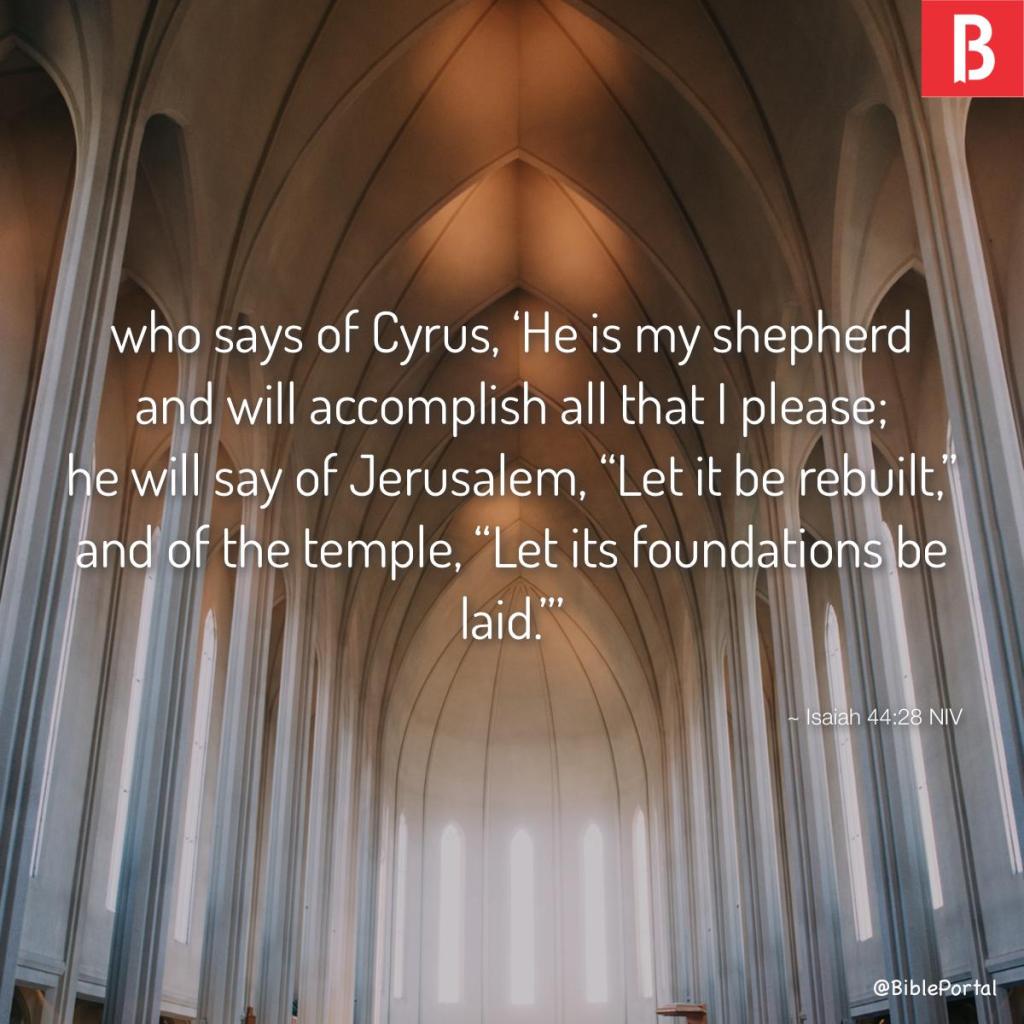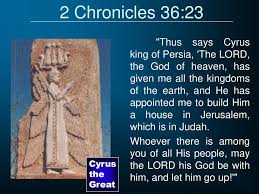Whole Edict: Rebuild the Temple, the House of God in Jerusalem

SHAHANSHAH, CYRUS II EMPEROR OF PERSIA

Cyrus, the founder of Achaemenid Persian empire and ruled it from 549 BC to 529 BC. The conquest of the great and ancient city of Babylon in 539 BC made Cyrus the ruler of a vast domain from the Aegean and the Mediterranean Sea in the west to the Indus river of India in the east. Nebuchadnezzar II of Babylonia destroyed Jerusalem in 586 BC and forced the Jews to live in exile.

Cyrus is famous in the Books of Old Testament of Holy Bible for freeing the Jews held captive in Babylonia. Cyrus had allowed more than 40,000 Jews to return to their Promised Land in 537 BC. He had asked them to take back the gold and silver utensils that were looted from the House of God in Jerusalem.

Prophets Isaiah and Jeremiah foretold the destruction of Jerusalem, captivity of Jews and then release with the coming of Cyrus. He is remembered in the Cyrus Legend first recorded by Xenophon, a Greek soldier and author of Cyropaedia. Greek historian Herodotus has described Cyrus as tolerant, ideal monarch, Father of Persian people and as the Liberator of Jews held captive in Babylonia. Cyrus had conquered Lydia, Syria, Babylon, and Palestine. In the year 1971, Iran celebrated the 2,500th anniversary of the founding of the monarchy by Cyrus. He is glorified in the Books of The Old Testament.

Book of Jeremiah, chapter 29, verse 10, the LORD says, “when seventy years are completed for Babylon, I will come to you and fulfill my gracious promise to bring you back to this place…”

Book of Isaiah, chapter 44, verse 28 : God says of Cyrus, “He is my shepherd and will accomplish all that I please; he will say of Jerusalem, “Let it be rebuilt,” and of the temple, “Let its foundations be laid.”

Book of Isaiah, chapter 45, verse 13 : “I will raise up Cyrus in my righteousness; I will make all his ways straight, he will rebuild my city and set my exiles free, but not for a price or reward,” says the LORD Almighty.

Shahanshah’s Edict of Restoration

Cyrus’s Edict to rebuild the House of God in Jerusalem is stated in the Book of 2 CHRONICLES, chapter 36, verse 23, and is reproduced in the Book of EZRA, chapter 1, verses 2 and 3.


This is what Cyrus King of Persia says;
“The LORD, the God of heaven, has given me all the kingdoms of the earth and he has appointed me to build a temple for Him at Jerusalem in Judah. Anyone of His people among you- may his God be with him, and let him go up to Jerusalem in Judah and build the temple of the LORD, the God of Israel, the God who is in Jerusalem.”
CYRUS CYLINDER

A clay cylinder was discovered in the foundations of the Esagila temple dedicated to chief Babylonian god Marduk. In cuneiform script, the following statement was inscribed on the clay cylinder:
….I am Cyrus, King of the world. When I entered Babylon…. I did not allow anyone to terrorise the land….I kept in view the needs of people and all its sanctuaries to promote their well-being…. I put an end to their misfortunes. The Great God has delivered all the lands into my hand; the lands that I have made to dwell in a peaceful habitation….

The Legacy of Emperor Cyrus

He was more than a great conqueror who founded an empire. He is best remembered for his unprecedented tolerance and magnanimous attitude towards those he vanquished. He showed a great forbearance and respect towards the religious beliefs and cultural traditions of other races. His policy of religious toleration and contribution to the rebuilding of several nations’ temples earned him the homage of all the people whom he had ruled.

In the Book of Isaiah, chapter 45, verses 1 to 6, Cyrus is praised as the ‘ANOINTED OF THE LORD’. The Greeks whom he conquered regarded him as ‘Law-Giver’. The Babylonians treated him as ‘The Liberator’. The Iranians regard him as ‘The Father’. He is considered to be upright, generous, and benevolent.

The Holy Book of Quran in Surah Al-Kahaf, verse 18 referred to a person known as “ZUL-QARNAIN” or “DHUL-QARNAYN”, a person wearing a crown of two horns like a ram. Cyrus, a Zoroastrian by faith, promised not to force any person to change his religion and faith and guaranteed religious freedom for all.

Rebuild BETH-EL, House of God at Temple Mount, Jerusalem:

The House of God, the Temple in Jerusalem acts as the figurative “footstool” of God’s presence in the physical world.

The First Temple was built by King Solomon in 957 BC. It stood for about 375 to 410 years. The Babylonians destroyed it in 586 BC. The Second Temple was completed during 516 BC and the Roman Emperor POMPEY desecrated it in 63 BC. King Herod had renovated it in 19 BC. The Roman troops of General TITUS totally destroyed it in 70 CE. Just the Western outer wall of the Temple still stands today. An Islamic shrine, the Dome of Rock was built on the site of the Temple Mount in late 7th century CE, and the al-Aqsa Mosque also stands in the temple courtyard.

The Jews envision the construction of the Third Temple in Jerusalem. The building of religious shrines on top of the ruined monuments of other faiths causes problems for rebuilding the Temple Mount. This is a problem that Indians have encountered repeatedly in all of their holy places such as Varanasi, Mathura, and Ayodhya.

If Shahanshah Cyrus is asked to decide on the religious dispute between Muslims and Jews, he would direct us to rebuild the original House of God or Beth-El at Temple Mount in Jerusalem and to restore the faith and the worship of God that it represents. Let us rebuild ‘House of God’ and let its foundations be laid where it belongs.


